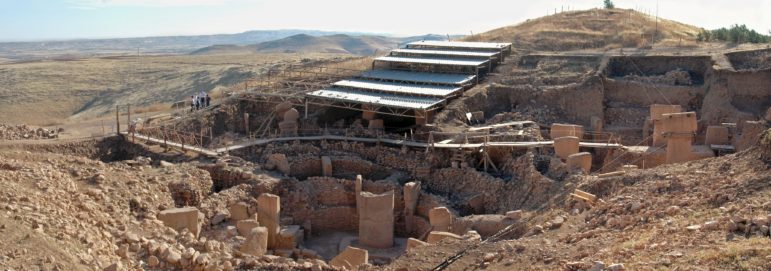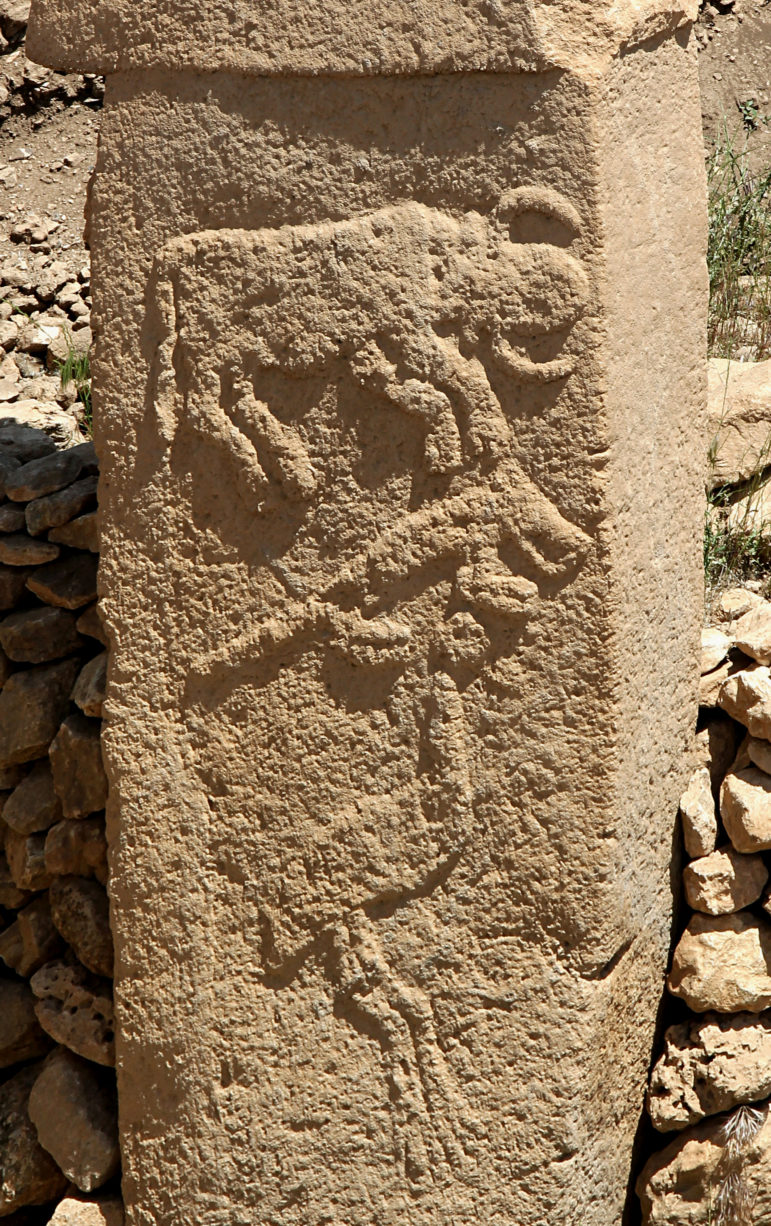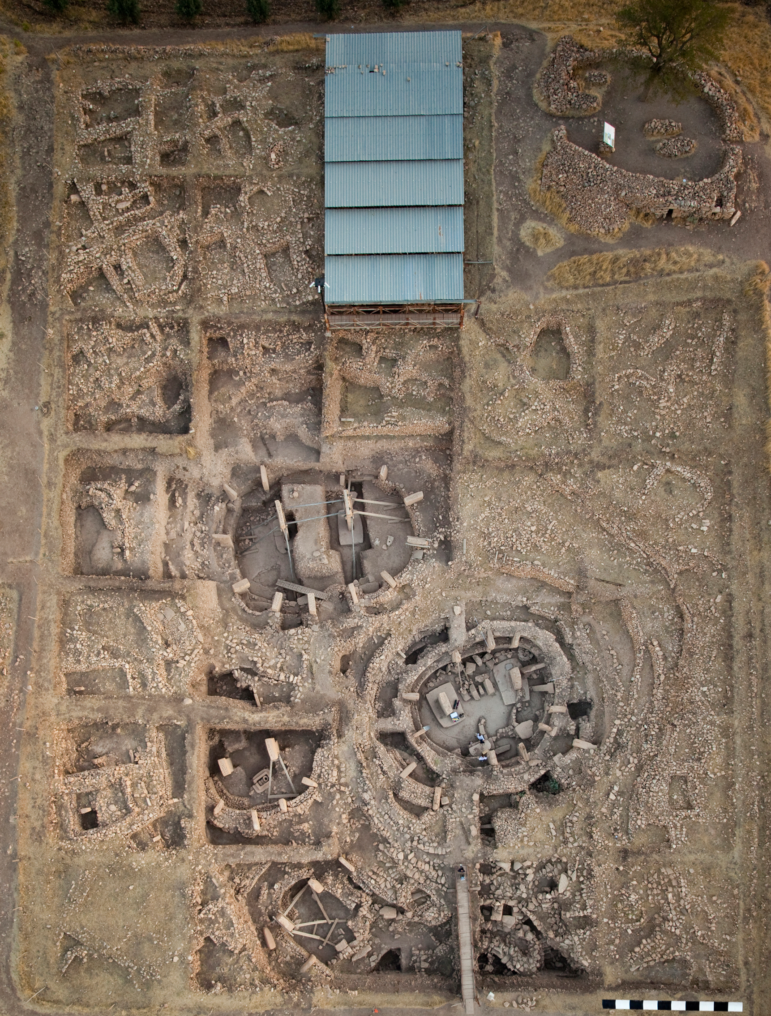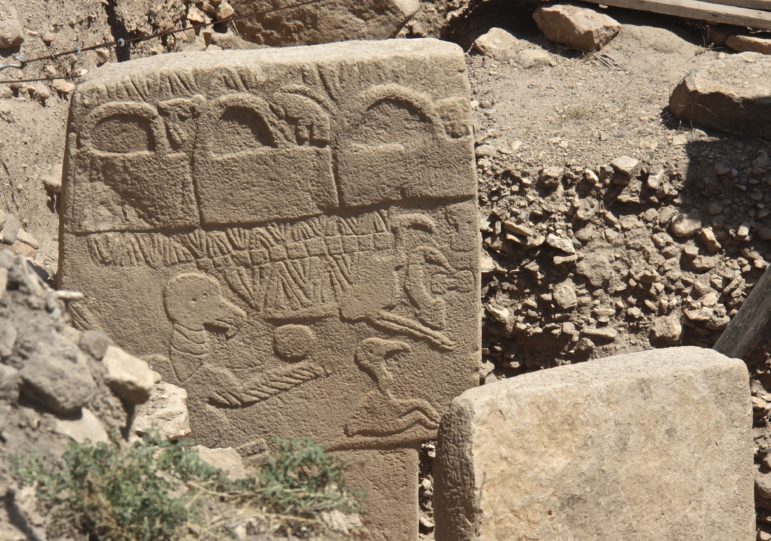TWH – Göbekli Tepe straddled the transition from hunter-gatherer culture to farming culture, and is considered the world’s oldest known monumental complex.
The first findings from Göbekli Tepe claimed that in 9000 B.C.E., people built it as a ritual center and before they had begun to settle in villages or to invent farming. Some archaeologists labeled the site as “The World’s First Temple.” They argued that religious rituals drove the invention of farming.

Panoramic shot of Göbekli Tepe – Image credit: Rolfcosar – CC BY-SA 3.0
More recent finding have challenged that World’s First Temple model.
Klaus Schmidt, a German archaeologist, began the excavations in the 1990s. He died in 2014. Lee Clare, Ph.D., coordinator of research and fieldwork at Göbekli Tepe, replaced him. Schmidt is associated with the World’s First Temple model. Clare is associated with challenges to that model based on new findings.
Göbekli Tepe and its importance
Located in southeastern Turkey, Göbekli Tepe lies 90km (about 55 miles) east of the upper Euphrates. People used it from roughly 9000 to 8200 B.C.E.
Schmidt found 20 circular enclosures made of stone pillars. The largest enclosure had a diameter of 20m (~65.6 ft). At the center of the enclosure, two T-shaped pillars stood 5.5m (~18 ft) tall. Carvings covered the pillars. Some depicted animals, others highly stylized humans.

Carved animal reliefs – Klaus-Peter Simon – CC BY-SA 3.0
According to Tepe Telegrams, the transition from hunting and gathering took hundreds of years or longer. People had to first experiment with cultivation, processing, storing, and cooking plants. To process grains, people had to experiment and invent grinding stones.
This transition first occurred in the areas around the upper Euphrates and Tigris rivers (Turkey, Syria, and Iraq). Wild varieties of Einkorn, emmer wheat, barley, and other “founder crops” grow in this region. DNA evidence has confirmed that people had domesticate wheat in this area.
The World’s First Temple model
Tepe Telegrams reported that after excavations began in the 1990s, Schmidt began to interpret Göbekli Tepe as a ritual site without permanent residents.
According to the BBC, Schmidt theorized that the hunter-gatherers would gather at the site for communal feasting. While there, they would build the site. Then, they would disperse.

Aerial view of the archaeological site of Göbekli Tepe: main excavation area with four monumental circular buildings and adjacent rectangular buildings – Image credit: German Archaeological Institute, photo E. Kücük. – Dietrich L, Meister J, Dietrich O, Notroff J, Kiep J, Heeb J – CC BY 4.0
This diversion of labor from hunting and gathering created challenges. When building the site, people were not hunting and gathering, but still needed to eat. This challenge would have led to experimenting with growing plants. Domestication would have begun.
Archaeology noted that Schmidt promoted the idea that “complex social organization and the performance of rituals actually predated permanent settlement.”
Schmidt argued that Göbekli Tepe functioned as an innovation center. From that center, knowledge of new farming tech spread outwards. In his view, ritual activity drove the invention of farming and settlements in the Neolithic. He said, “First the temple, then the city.” These theories became “The World’s First Temple” model.
New findings challenge The World’s First Temple model
Clare argues that the World’s First Temple model rests on several characteristics. First, archaeologists found no evidence of settlement at Göbekli Tepe. Second, they failed to find any evidence of a nearby water source. Third, they found no evidence of domesticated plants or animals. Fourth, when people left Göbekli Tepe, they buried the enclosures and pillars in an abandonment ritual.
New findings have called into question all the above characteristics.
Settlement
Archaeology reported that roof canopies were built to protect the excavation areas. The post holes for those canopies required digging down to bedrock.
Clare said, “We found middens, fireplaces, hearths, lithics—all smelling very domestic. For me, there was domestic activity from the beginning right to the very end.”
Clare commented that the tool types found at Göbekli Tepe were similar to those of a settled population.
Water source
Clare said archaeologists found a pit carved out of the rock, diameter 8m (~26.2 ft) and a depth of 2.8m (~9.1 ft). This structure has similarities to the rainwater harvesting structures in nearby sites.
Archaeology reported that archaeologists found a channel carved out of rock similar to other channels used to collect rainwater on other sites.
Plant Domestication
In Göbekli Tepe, archaeologists have found over 7,268 grinding stones. According to Tepe Telegrams, a grinding stone has two parts: a hard, flat surface and a handheld object, a “hand stone.”
The grinder would place the grains on the hard, flat surface. The handheld objects would act like a potato masher. Experiments showed that one worker grinding for eight hours could produce enough to feed five to ten people.
Tepe Telegrams reported that archaeologists found evidence of the upper parts of grass plants, which would be consistent with cereals gathered in sheaves.
Abandonment ritual or erosion
Archaeology also reported that German Archaeological Institute archaeologist Moritz Kinzel argued against the ritual backfilling of the site. Ritual backfilling would have occurred evenly throughout each enclosure. The data shows an unequal pattern. Parts of the enclosure closest to the hill slope show the most damage. That would be consistent with hill erosion. Earthquakes occur in this area, making soil disturbances likely.
New interpretations
Clare argues in that same magazine article that Göbekli Tepe was a last stand of hunter-gatherers against the Neolithic Revolution. He based that on the animals carved on the T-shaped pillars. They show wild, threatening animals, stylized humans, phalli, and human skulls.
Notches on the pillars indicated that the enclosures had roofs. This would have made the ritual space dark. Archaeologist Thomas Zimmermann, interprets this darkness and the sculptures of threatening animals to indicate male dominance.

Vuture carving – Image credit: Sue Fleckney – CC BY-SA 2.0
According to this interpretation, by 8200 B.C.E. the Neolithic had won. People then abandoned Göbekli Tepe.
In that same Archaeology article, archaeologist Barbara Horejs said, “It’s impossible to understand 12,000-year-old symbols in such a direct way.”
Archaeologist Mehmet Özdoğan interprets the animal carvings as protective rather than threatening.
Archaeologist Laura Dietrich analyzed the grinding stones found at the site. She claimed that people at Göbekli Tepe had developed ways to process and cook grains. Horejs rejects a binary division between hunter-gatherers and the Neolithic.
“Sociocultural processes like this aren’t either-or; they’re continuous,” she said. “Hunter-gatherer life doesn’t stop immediately because people start cultivating grain.”
The Wild Hunt is not responsible for links to external content.
To join a conversation on this post:
Visit our The Wild Hunt subreddit! Point your favorite browser to https://www.reddit.com/r/The_Wild_Hunt_News/, then click “JOIN”. Make sure to click the bell, too, to be notified of new articles posted to our subreddit.
